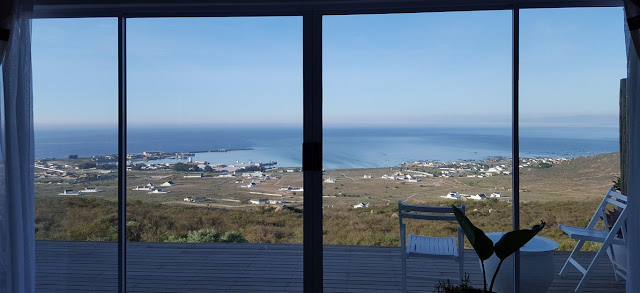This post is to wrap up the trip.
The trip went well without any negative events. We followed our planned route, with a few exceptions where there were no roads! The route can be done with a 2x4 'bakkie'. Car may suffer.
The Ford Ranger 2.2 (diesel, double cab, 4x4) gave no
troubles at all. Although word goes
around that the standard tyres (Continental CrossContact 255/70 x16) are poor, and prone to
punctures, and specially side-wall punctures, we had no punctures at all. Of the 10 000 km we drove, about 40%
were gravel, or not tarred. I post a KMZ file (opens in Google
Earth) that can be loaded to show the exact route we drove as on the map below.
https://drive.google.com/open?id=0B1bFxqxkWpJUM1ZyUThOYW1mNTQ
 |
| We started at the green on the bottom of the map, followed the green, and moved east and south on the red line. The blue is the actual route. |
All the KMZ files were recorded with GeoTracker
(Android app), except the part from Twee Rivieren to Augrabies.
We drove:
- 10 025 kms
- used 954 litres of diesel (no water or oil needed)
- ‘filled up’ 17 times
- with a fuel consumption of 11.34 km/l over this period
- i used 500ppm diesel
- i used 'Fuelio' a free Android app to record the fill-ups
Total cost was about R30 000 (i.e. money spent
directly); with accommodation and diesel the main contributors. The clip from Excel shows expenses in the categories captured. The graph below shows the same data graphically.
Things we took with and not used (i.e. did not need):
- too much clothes
- extra spare tyre
- extra water (25l)
- tools (spanners, various pliers, wire, extra jack, 'planks' to jack up on (not to depress in sand)
- kindling
- medicines
- spade
- tripod for camera
- backpack (20l)
Best choices:
- A3 Flip-file with a double facing pages for A3 map, and
- printouts of payments for bookings (a few places did not know we were fully paid)
- multi-plug
- 'Cloth' coolbag (e.g. P'n'P style)
- 12V fridge
- snacks in Tupperware 'tray'
- proof of address
- change (small denomination money) for tips, curious, etc.
Maps:
We had the MapStudio Namibia Adventure Map (1:1 650 000 digital) 1st edition (bought ± Jan 2016). We bought it online, and printed it to a scale that fitted our needs per day. There are major mistakes on the map, e.g. roads shown as tar but are two-tracks, and vice versa, and roads that are cul de sac, but shown to connect with other roads, etc. We had various GPS programs we navigated with (mainly used CoPilot and Sygic). These are offline GPS navigation that don't need data, but GPS signal. They served us well. Many B, C and D roads' numbers changed and are not correct on paper and GPS maps. This however had little impact on our plans as it were upgrades of roads.
I took 1058 photos, totalling 4.74 GB. This number includes a few videos.
I used Flash Renamer to rename photos and used the standard: <ExifDate>_<ExifTime>_
'desired name'.
This will sort your pics in the date/time it was taken ... most useful. Renaming took <10 minutes per day.
Thx to Magriet, Dominique and Tania who looked after the house and dogs, Maretha for her 12V / 220V fridge, Dominique again for four plastic crates. Thx to family we stayed over with in Cape Town (Jean, Carel, Elaine, Hennie and Ria) and for all of you that followed the blog and supported us with Whatsapp and phone calls while on the trip.
Direct any questions to Johan at: johanbaard@gmail.com




























































